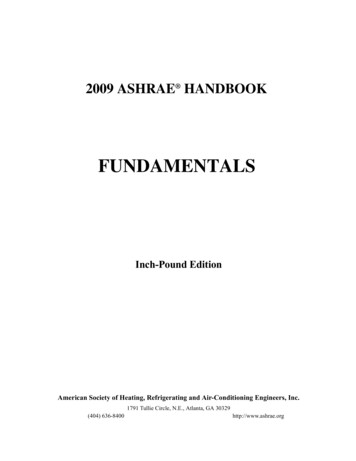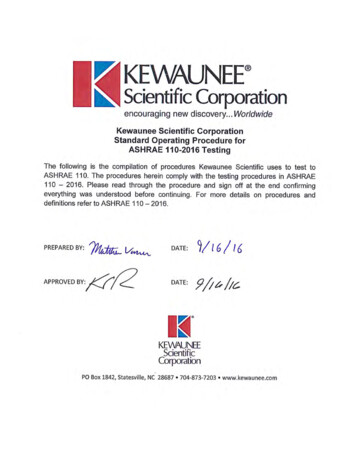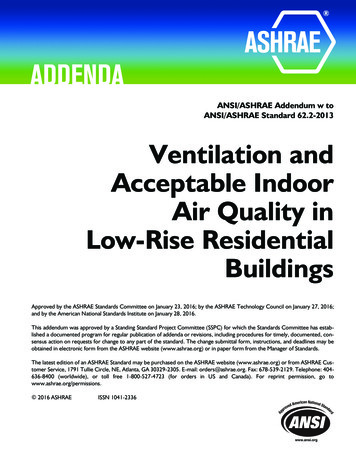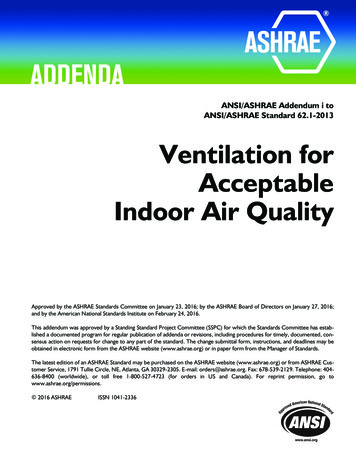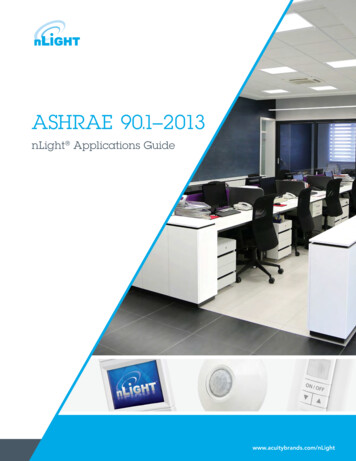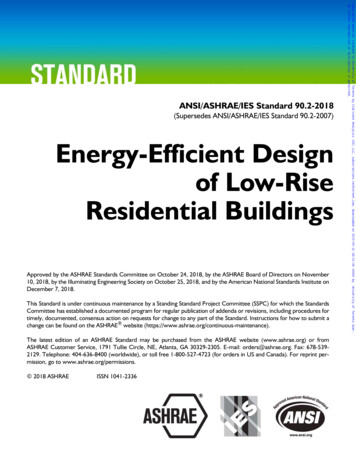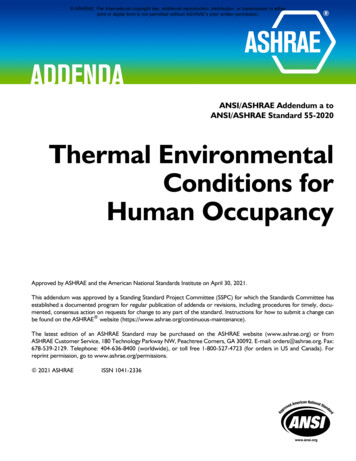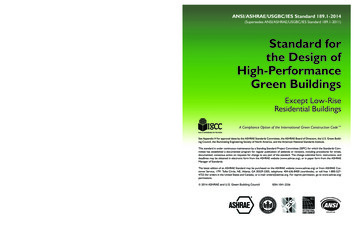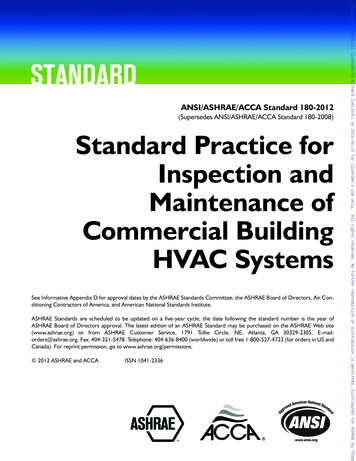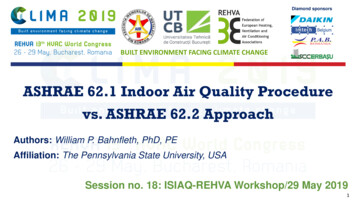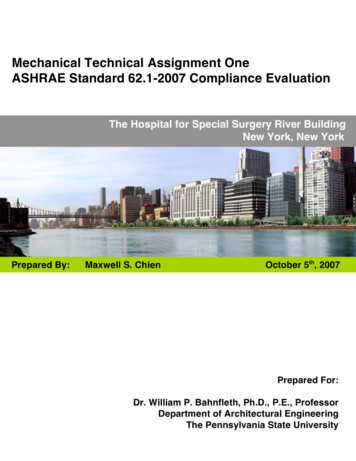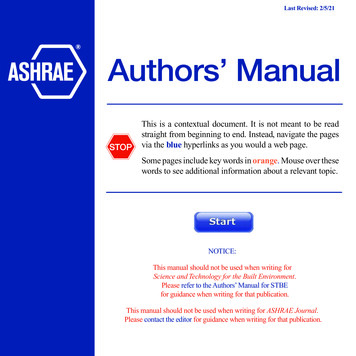
Transcription
Last Revised: 2/5/21Authors’ ManualSTOPThis is a contextual document. It is not meant to be readstraight from beginning to end. Instead, navigate the pagesvia the blue hyperlinks as you would a web page.Some pages include key words in orange. Mouse over thesewords to see additional information about a relevant topic.NOTICE:This manual should not be used when writing forScience and Technology for the Built Environment.Please refer to the Authors’ Manual for STBEfor guidance when writing for that publication.This manual should not be used when writing for ASHRAE Journal.Please contact the editor for guidance when writing for that publication.
Before You Begin. Agreement to Publish(N/A for books) Potential Sources of BiasDisclosure (N/A for books) Copyright Information Avoiding Plagiarism Obtaining Permissions CommercialismGeneral Formatting Resources Document Formatting Equations Figures (sample) Units of Measurement Tables (sample) Converting Graphicscreated in Excel or WordReferences and Citations(sample) Technical PapersSubmission Requirements Conference PapersSubmission Requirements Extended AbstractSubmission Requirements Book Submission GuidelinesPapers Resources Paper Organization Paper Publication Process Manuscript CentralUpload InstructionsBooks Resources Book Organization Book Publication Process
Plagiarism is the act of taking other people’s words or images and passing themoff as your own. Plagiarism is discouraged because it not only affects the reputation of the author and publication, but also may encourage others to plagiarizeyour work and lessen its impact. Plagiarism is also considered intellectual theft,whether it is done intentionally or accidentally.EXAMPLES OF PLAGIARISM AND HOW TO CORRECT IT:ASHRAEAuthors’ ManualAvoidingPaper OrganizationPlagiarism1. Copying text from another source word for word without attribution. Directquotations from another source should be in quotation marks and includecitation attribution: “The best chance we have of addressing the combined challenges of energy supply and demand, climate change and energy security is to accelerate the introduction of new technologies for energy supply and use anddeploy them on a very large scale” (Friedman 2008, p. 34).2. Copying data from another source without citing the original source. Datafrom another source should include citation attribution: For reference, estimates of water-related energy use range from 4% to13% of U.S. electricity use (Copeland 2014).3. Reproducing images either from another publication, an industry source, orthe Internet without attribution. All images not created by you need permissions from the copyright holder to be republished. (See the examples of Images Showing Appropriate Attribution.) See Obtaining Permissions for moredetails.4. Using data from another source in an image or table without attributing theoriginal source of the data. If the data was not collected by the authors publishing the work, it must be cited. (See the examples of Images and TablesShowing Appropriate Attribution.)A Note on ASHRAE PublicationsImages and data from ASHRAE publications can generally be used in subsequent ASHRAE publications. However, you still must obtain permission to reprint these images and data from ASHRAE, and these images and data must stillbe cited appropriately in text, in images, and in tables. To request permission touse ASHRAE copyrighted content, visit ASHRAE’s website.A Note on U.S. Government PublicationsImages and data from U.S. Government sources can often be used without permission. However, these images and data must still be cited appropriately in text,in images, and in tables.A Note on Fair UseThe principle of fair use applies to certain material used in criticism, comment,news reporting, teaching, scholarship, and research. Fair use generally appliesto information replicated in an educational setting without intent to distributeor profit from the information, or information that is changed significantly fromits original source. It is better to err on the side of caution and try to obtainpermission rather than risk plagiarism. More information can be found atwww.copyright.gov.
ASHRAEAuthors’ ManualObtainingPermissionsRequesting permission to reproduce figures and tables from other sources is theresponsibility of the author, as is payment of any fees the copyright holder mayrequire before granting permission. Authors should never assume that materialtaken from software or downloaded from the Internet may be used without obtaining permission. See Avoiding Plagiarism for more information.1. Permission to reproduce material must be obtained during the writing stage.2. Classify all information from another source as either “in the public domain” or “requires copyright permission.”Publications from federal agencies are all in the public domain, whichmeans the information must be cited in your text and referenced at the endof your manuscript but you do not have to request permission to use it. Material from private publishers—including publishers of your ownpreviously published work—requires copyright permission. If permission is not granted, you cannot use the material in your manuscript.» For all photos, figures, tables, and data from tables from other sourcesthat require permission, you must cite the source in your text andreference it at the end of your manuscript in addition to crediting thecopyright holder for permission to use the material. NOTE: Table data do not require copyright permission as long as thetable is reformatted. However, the material must still be cited, so reference information is required.3. For those sources that are not in the public domain, request permission fromthe copyright holder to use/reproduce the information. Submit a request letter or the completed Permission Request Form to thecopyright holder and ask for a reply within 30 days. They should reply directly to you, not ASHRAE staff. To request permission to use ASHRAE copyrighted content, visit ASHRAE’swebsite.4. Be sure to reference all materials from other sources where they appear inyour manuscript, including credit lines as designated by copyright holders.5. Submit permission-granted letters with the completed manuscript. Materialcannot be published without permission, and no editing or layout work willbegin on the manuscript until all permissions have been received.
ASHRAEAuthors’ ManualCopyrightASHRAE retains exclusive copyright of papers published as part of the ASHRAEWinter or Annual Conference Papers via the ASHRAE Technology Portal andin ASHRAE Transactions. Works published by ASHRAE are final and completeworks.Under ASHRAE copyright policies, authors retain the right for certain specificuses of their paper without requesting ASHRAE’s permission. Only the “as published” version of the paper may be used by the author. These uses are as follows: to make copies of the paper for their own personal use; to make copies and distribute copies of the paper to researchers or customers of the author’s employer for the personal use by such researchersor customers; to post the paper as published by ASHRAE on the author’s personal,institutional, or corporate website or server with a link to ASHRAE’swebsite; to present the paper (after ASHRAE publication) at a meeting or conference and to distribute copies of such paper to the delegates attending themeeting with written permission from ASHRAE; to allow use of the paper by the author’s employer for posting on the employer’s website, for use by the employer in training or educational courses offered by the employer, for internal research work that is conductedby the employer, and for internal publications published by the employer; to include the paper in full or in part in a thesis or dissertation; to include the paper in a printed compilation of works of the author, suchas collected writings or lecture notes; and to prepare other derivative works, such as extending the paper into booklength form, or to otherwise re-use portions or excerpts in other works,providing there is acknowledgement of its publication by ASHRAE.Other uses must be authorized by ASHRAE. Authors should contact ASHRAEexplaining their specific need and identifying the paper and ASHRAE publicationin which the paper appeared.Others wishing to use ASHRAE copyrighted content should visit ASHRAE’swebsite for more information and to make their request.
ASHRAEAuthors’ ManualFormattingFigures1. Original figures or other artwork should be submitted with the manuscriptwhenever possible. For information on reprinting a figure from anothersource, see Obtaining Permissions.2. Use only 1 point (0.014 in. [0.35 mm]) or thicker lines—smaller lines willnot reproduce well.3. Figures to be reproduced in black and white should use patterns or shapesto distinguish sections instead of coloring and shading. Figures to be reproduced in color should have touching colors that differ significantly so thatthere can be no confusion in understanding the data. (Note that papers arepublished in color as part of the ASHRAE Winter or Annual Conference Papers in the ASHRAE Technology Portal and in black and white in ASHRAETransactions.)4. Each figure should have a brief legend or descriptive labels, as appropriate.Any text included in a figure (except the figure caption) should be embedded as part of the image file and not contained in a separate text boxthat is not part of the image file.5. Provide dual units for all measurements, preferably as two figures.6. All figures must be provided to ASHRAE as individual TIF (preferred) orEPS files in either CMYK mode (for color) or Grayscale mode (for blackand white). All images should be saved at high resolution (600 dpi for lineart ; 300 dpi for photographs) and at least 4 in. (102 mm) size or greater. SeeConverting Graphics Created in Excel or Word for instructions on graphicconversion. Figure files should be clearly labeled (i.e., Figure1.tif, Fig2.tif,Fig3-2, etc.). Multiple-part figures, such as a figure with parts (a) and (b), mustbe submitted as one file with all parts included.7. Every figure must be referenced in the text by name/number, where “Figure”is capitalized (e.g., “ as shown in Figure 2.”).8. Figures must be numbered consecutively as they appear in the text.9. Prepare a list of captions for figures and place it at the end of the manuscript(this applies to papers only; it is not applicable for book projects).
ASHRAEAuthors’ ManualFormattingTables1. All table titles should be descriptive but concise.2. Original tables should be submitted with the manuscript whenever possible.For information on reprinting a table from another source, see ObtainingPermissions.3. Titles appear above the tables, and every major word in the title is capitalized.4. Number tables consecutively and in the order they are mentioned in thetext.5. Tables used in the manuscript should not be image files but should beeditable tables (such as those created in Word, Excel, Framemaker, InDesign,etc.).6. Use only 1 point (0.014 in. [0.35 mm]) or thicker lines—smaller lines willnot reproduce well.7. Vertical and horizontal lines should be avoided except to delineate the topand bottom of a table and to separate the heading row from the data, unlesslines are otherwise necessary for clarity or organization of the data.8. Label each column with a heading and include units of measurement andother necessary qualifying information. Units should be set off with a comma (e.g., “Velocity, m/s”).9. Provide dual units for all measurements.10. Every table must be referenced in the text by name/number, where “Table” iscapitalized (e.g., “as provided in Table 5”).
ASHRAEAuthors’ ManualUnits ofMeasurementASHRAE policy requires dual units of measurement—inch-pound (I-P) andInternational System of Units (SI). You are required to provide dual units whensubmitting manuscripts; ASHRAE staff will not convert units for you. SeeASHRAE’s SI Guide for HVAC&R for comprehensive guidance on using SIunits. Some guidelines are as follows:1. The units used in calculating the work being reported should be listed firstwith the alternate system of units following in parentheses.2. Always spell out all units when they are used without a number.3. Do not mix symbols and names in the same expression.4. Do not express plurals by adding an “s”.5. Do not use periods with units of measurement. EXCEPTION: in. for inch6. Leave a space between the numerical value and the unit of measurement.EXCEPTION: There is no space between number and degree of plane angleor degrees of temperature (45 , 62 F, 20 C) or the number and the percentsymbol (5%).7. “L” is the symbol for litre, not lowercase “ell” or script “ell.”8. “Centi-” is not an acceptable SI prefix, and the use of cm should be avoided.9. For currency, include the monetary unit of the country where the research isbased followed by the U.S. dollar conversion in parentheses.
ASHRAEAuthors’ ManualFormattingEquationsEach significant equation or formula should be displayed on a separate line. Centerequations and place consecutive equation numbers flush right in parentheses.EXAMPLE:a2 b2 f 2(1)wherea2 applesb2 bananasf 2 fruit saladIf an equation requires more than one line, break it before an operational sign,and align the operational signs on the left.EXAMPLE:E (a b c)/(m n o) d e f)(2)If two or more displayed equations are grouped together, leave space betweenthe individual equations:a b c(3)D f – ab2(4)mon rst(5)Spell out the word “equation” and capitalize it in the text when referring to specific, numbered equations. In a highly mathematical or theoretical work, considerdeveloping equations in appendices rather than in the body of the manuscript.Please note that all equations must be retyped in our pagemaking program—this is one reason we require a hard copy of the manuscript—and thereforeshould be checked thoroughly by the author at the proofreading stage.
ASHRAEAuthors’ ManualBook PublicationProcessMost books are the result of an ASHRAE research project. A subcommittee maybe designated to handle the review process of a committee-sponsored project,using committee members or other persons with expertise in the area of concern.The ASHRAE submittal, review, and publication process proceeds as follows:1. The author indicates intent to submit a manuscript to Special Publicationsand receives the Authors’ Manual.2. The author prepares the manuscript, including artwork, according to this Authors’ Manual.3. The cognizant ASHRAE Technical Committee selects qualified reviewers.4. Reviewers send reviews and comments to the author.5. The author revises the manuscript and/or rebuts comments and provides arevised manuscript or rebuttal to the cognizant Technical Committee.6. Reviewers complete an additional review.7. The review process continues until the manuscript is accepted or rejected forpublication by the cognizant Technical Committee.8. After the manuscript is approved for publication, the author submits a finalMicrosoft Word file and separate figure files electronically to Special Publications (see Book Submission Guidelines) and the author is informed of atentative publication schedule.9. Special Publications editors edit the manuscript for grammar, punctuation,clarity, and consistency with ASHRAE policies, as well as completeness ofparts. It is then laid out into pages, with the figures and tables incorporated.10. The editors send a PDF proof to the author, often including queries thatrequire responses from the author. The author proofreads the manuscriptand returns replies to the editors’ queries within a mutually agreed upon(hopefully short) timeframe.11. The book is published and offered for sale in the ASHRAE Bookstore asboth the physical, printed book and a PDF available for download.12. The author receives a complimentary copy of the published book.
ASHRAEAuthors’ ManualPaper PublicationProcessTechnical Paper and Conference Paper submittal, review, and publication activity is coordinated by the ASHRAE Conference Program Administrator. Thepapers publication process proceeds as follows:1. The author indicates intent to submit a paper to the ASHRAE ConferenceProgram Administrator and receives instructions and the Authors’ Manual.2. The author prepares the paper, including artwork, according to the Authors’Manual and the Author’s Template for Technical Papers or the Author’s Template Conference Papers.3. The author uploads the paper through the applicable website as indicatedin the Technical Papers Submission Requirements and Conference PapersSubmission Requirements.4. The ASHRAE Conference Program Administrator selects qualified reviewers.5. The reviewers carefully review the paper and submit reviews online.6. The author receives reviews and comments. The author revises the paperand/or rebuts the comments and uploads a revised paper or rebuttal.7. The reviewers are notified that a revised paper requires additional review.8. The review process continues until the paper is accepted or rejected.9. After the paper is accepted, the author uploads the final paper through the applicable website in the appropriate format as indicated in the Technical PapersSubmission Requirements and Conference Papers Submission Requirements.10. The accepted paper is scheduled for presentation at an ASHRAE Winter orAnnual Conference or a Topical Conference.11. ASHRAE staff editors edit and format the Technical Paper and send a PDF tothe author, who proofreads the paper and returns responses to the editors’ queries by the supplied deadline, or staff editors scan the Conference Paper foradherence to the Author’s Template for Conference Papers and the author addresses any noted errors and provides a revised PDF by the supplied deadline.12. After the conference editors may send the author of a Technical Paper comments and questions generated at an ASHRAE Winter or Annual Conference. The author returns responses to the editors.13. Technical Papers are available as preprint PDFs in the ASHRAE Winter orAnnual Conference Papers in the ASHRAE Technology Portal and publishedas final paper with the questions and comments and authors’ responses inASHRAE Transactions, Conference Papers are published as final PDFs in theASHRAE Winter or Annual Conference Papers in the ASHRAE TechnologyPortal, and papers for Topical Conferences are published as PDFs on flashdrives or downloads for the individual conferences. All papers are availablefor purchase from the ASHRAE Bookstore as downloadable PDFs.
ASHRAEAuthors’ ManualBook SubmissionGuidelinesThe following materials are required for book manuscript submission:1. The complete manuscript in Microsoft Word and the figures provided asseparate TIF or EPS files saved at high resolution. Tables should be editableand NOT submitted as images.2. A laser printout of the complete manuscript including text, tables, and graphics.With the printout, include a cover sheet with the following information: Proposed title of the book Whether the book will include supplemental materials online (Excelspreadsheets, PDFs, Word files, etc.) Sponsoring ASHRAE Technical Committee and/or ASHRAE researchproject number, as applicable Author names in desired order with (if applicable) ASHRAE membership grade, academic degrees at the doctoral level, and professionalcertifications for each author An “About the Authors” paragraph Complete contact information for the corresponding author, includingmailing address, phone and fax numbers, and email address A paragraph describing the book (to be used on the back of the book, inthe bookstore, and in marketing materials)3. Electronic or printed copies of any permissions granted for reproducing material from other sources (see Obtaining Permissions)4. The completed Marketing QuestionnaireSee Document Formatting and Book Organization for additional requirements.Manuscripts should be submitted to:Cindy MichaelsEditor, Special Publications180 Technology Parkway, Peachtree Corners, GA 30092 USAcmichaels@ashrae.orgTelephone: 678-539-1187Book Publication Process provides information on how the process will proceedafter submission of the manuscript to Special Publications.
ASHRAEAuthors’ ManualTechnical PapersSubmissionRequirementsTechnical Papers most often report on ASHRAE-sponsored research and unsolicited research in HVAC&R technical areas.All Technical Papers undergo critical, double-blind peer review by three or morecompetent specialists to ensure high quality of content. A paper must be acceptedby three reviewers to be approved for an ASHRAE Winter or Annual Conference.The Technical Paper review activity is coordinated by the ASHRAE ConferenceProgram Administrator, who can be contacted if you have any questions duringthe paper submission and review process. File submission is done online viaManuscript Central. Manuscript Central Upload Instructions are available inthe “Instructions & Forms” section of that website.The Technical Paper submission requirements are as follows:1. Upload an Agreement to Publish form that is signed by the main author.2. Download the Authors’ Template for Technical Papers for a Microsoft Word file to use when writing the paper; also see an example paper.3. Typed manuscripts for Technical Papers must not exceed 30 double-spacedpages (including references and tables) and can contain a maximum of 12figures. Dual units of measurement should be included in the text, tables,and figures. See Document Formatting for additional requirements. Uploadthe paper as a Microsoft Word file for review. Authors should NOT identifythemselves in manuscript files to enable reviewers to maintain a blind review.4. Upload an author’s list as a separate Word file that includes the following: The title of the paper Author names in desired order, principal author first, with (if applicable)ASHRAE membership grade, academic degrees at the doctoral level, andprofessional certifications for all authors. An author note with job title, affiliation, and address for each author. Complete contact information for all authors.Reviews will be done using ASHRAE’s online review process, and ASHRAEstaff editors will edit and lay out the accepted Technical Paper. (See Paper Publication Process for more information.)
ASHRAEAuthors’ ManualConference PapersSubmissionRequirementsConference Papers presented at ASHRAE Winter or Annual Conferences reporton research in progress, applications, case studies, and other topics in HVAC&Rtechnical areas. Conference Papers presented at Topical Conferences report onspecific technical areas within HVAC&R, depending on the conference.Annual/Winter and Topical Conference Papers undergo single-blind review (unless otherwise indicated in the call for papers) by two or more reviewers to ensurehigh quality of content. A paper must be accepted by two reviewers to be approved for a conference. The Conference Paper review activity is coordinated bythe ASHRAE Conference Program Administrator, who can be contacted if youhave any questions during the paper submission and review process. File submission is done online via ConfTool or Conference Exchange (2019 AnnualConference only) using the link provided for each individual conference.The Conference Paper submission requirements are as follows:1. Upload an abstract for review. The abstract must be accepted before the paper can be submitted. When you upload your abstract you will be assignedan ID# for your submission (one ID# for both the abstract and the paper).2. Upon acceptance of the abstract, submit the paper based off of the acceptedabstract. Download the Authors’ Template for Conference Papers for a Microsoft Word file to use when writing the paper; also see an example paper. Conference Papers must not exceed eight single-spaced pages in length(including references, tables, and figures) and must include an authornote at the bottom of page 1. Dual units of measurement should be included in the text, tables, and figures. See Document Formatting for additional requirements. Conference Papers being submitted should beconsidered “Final” by the author. Upload the Conference Paper as a PDFwith your assigned ID# as the file name. Please note that adherence to the Author’s Template and to the requirements set forth in this Authors’ Manual are significant factorsin determining the acceptance of your Conference Paper.3. Upload an Agreement to Publish form signed by the presenting author.Reviews will be done using ASHRAE’s online review process. (See Paper Publication Process for more information.)
ASHRAEAuthors’ ManualExtended AbstractSubmissionRequirementsExtended Abstracts presented as part of the Research Track at ASHRAE Annual Conferences report on research in progress, applications, case studies, andother topics in HVAC&R technical areas. Extended Abstracts are intended to bepreliminary research results that will eventually be expanded into a full paper.Extended Abstracts undergo single-blind review by two reviewers to ensure highquality of content. An abstract must be accepted by two reviewers to be approvedfor a conference. The Conference Paper review activity is coordinated by theASHRAE Conference Program Administrator, who can be contacted if you haveany questions during the paper submission and review process. File submissionis done online via ConfTool using the link provided for each individual conference.The Extended Abstract submission requirements are as follows:1. Upload an abstract for review. The abstract must be accepted before the Extended Abstract can be submitted. When you upload your abstract you willbe assigned an ID# for your submission (one ID# for both the abstract andthe Extended Abstract).2. Upon acceptance of the abstract, submit the Extended Abstract based off ofthe accepted abstract. Download the Authors’ Template for Conference Papers for a Microsoft Word file to use when writing the paper; also see an example paper. Extended Abstracts must not exceed three single-spaced pages in length(including references, tables, and figures) and must include an author noteat the bottom of page 1. Dual units of measurement should be includedin the text, tables, and figures. See Document Formatting for additionalrequirements. Extended Abstracts being submitted should be considered“Final” by the author. Upload the Extended Abstract as a PDF with yourassigned ID# as the file name. Please note that adherence to the Author’s Template and to the requirements set forth in this Authors’ Manual are significant factorsin determining the acceptance of your Extended Abstract.3. Upload an Agreement to Publish form signed by the presenting author.Reviews will be done using ASHRAE’s online review process. (See Paper Publication Process for more information.)Extended Abstract authors must give an oral presentation based on the acceptedwork as part of the ASHRAE Anual Conference Research Track. Accepted Extended Abstracts will be published in Part 2 of ASHRAE Transactions.
ASHRAEAuthors’ Manual“Figures to be reproduced in black and white should use patterns orshapes to distinguish sections instead of coloring and shading.”Sample Figures“Figures to be reproduced in color should have touching colors that differsignificantly so that there can be no confusion in understanding the data.”
ASHRAEAuthors’ ManualImages ShowingAppropriateAttribution
ASHRAEAuthors’ ManualImages and TablesShowingAppropriateAttribution
ASHRAEAuthors’ ManualSample Table
ASHRAEAuthors’ ManualPERFORMANCE EVALUATION FUNCTIONThe performance of any air-conditioning system depends on two factors:a. thermal comfortHeading LevelSamplesFirst LevelSecond Levelb. energy consumptionThermal ComfortThe most important variables that influence the condition of thermal comfort are air temperature, water vapor pressure in ambient air, relative air velocity, mean radiant temperature, activitylevel (heat production in the body), thermal resistance of the clothing, and purity of the air.Fanger (1970) defined a thermal sensation index by considering air temperature, water vaporpressure in ambient air, relative air velocity, mean radiant temperature, activity level, and thermal resistance of the clothing. PMV is the thermal sensation index given by Fanger (1970) andis internationally standardized. It is easy to use PMV when controlling an air-conditioning system because PMV is an index of human thermal sensation with one value for all seasons and iseffective for all temperatures that are neither extremely high nor extremely low. PMV rangesfrom –3 (cold) to 3 (hot). When PMV is zero, then thermal sensation will be neutral, i.e., neither cold nor hot. Broadly speaking, when PMV approaches zero then thermal comfortincreases.The first term on the right-hand side of Equation 14 indicates the mass of moisture in theincoming air, which comes in contact with the evaporator wall, and the mass of moisture in theoutgoing air. The humidity of the incoming air is calculated from a psychrometric chart with thehelp of the second-order curve-fitting method. The multiplying factor, (1 – b), corresponds tothe bypass factor of the evaporator. The second term amounts to mass of moisture in the incoming air bypassed through the evaporator and the mass of moisture in the outgoing air. The multiplying factor b corresponds to the bypass factor of the evaporator. The rate of change of specifichumidity of supply air when the evaporator wall temperature is more than the dew-point temperature is given byU a V d dW s e dt vU a 1 – [ W 3 [W 0 – W s .(1)The first two terms on the right-hand side of Equation 15 correspond to absolute or specifichumidity of incoming air, and the third term corresponds to outgoing supply air humidity.Specific Humidity of Thermal Space. The rate of change of the specific humidity of thethermal space is given byThird Level
ASHRAEAuthor
Feb 05, 2021 · ASHRAE Authors’ Manual Paper Organization Avoiding Plagiarism Plagiarism is the act of taking other people’s words or images and passing them off as your own. Plagiarism is discouraged because it not only affects the reputa-
